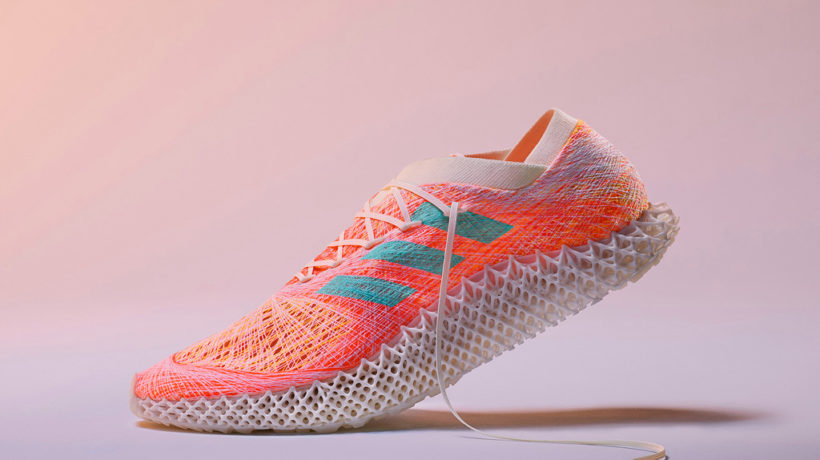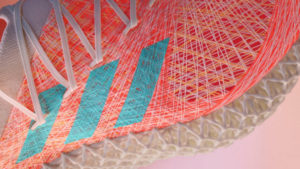Every year, Adidas introduces an experimental new shoe technology dubbed “Futurecraft.” These aren’t just bouncier foams or sneakers loaded with fitness tracking inside. They fundamentally reimagine how performance footwear is made—from creating shoes from ocean plastic, to 3D-printing midsoles, to building “Loop” shoes that can be ground up, melted, and made into brand-new shoes when you’re done wearing them.
This year is no exception, as Adidas introduces a new way of making uppers—the soft, cloth top of your shoe—called Strung. Most shoe uppers are made by cutting a square of cloth into a pattern, leaving scraps that fall to the floor. Strung is almost a zero-waste process. It entails a robot arm wrapping yarn around a pegboard very fast to build a textile from layer after layer of string, all of which gets fused together through heat. There is no stitching, no glue, and no eyelets, and no other components are added after the fact. Strung is what Adidas calls additive manufacturing: You build up a material layer by layer from scratch, rather than cutting away from existing material, which inevitably creates waste.
Adidas claims the Strung upper sidesteps the major shortcomings of existing woven technologies such as Nike Flyknit or Adidas Primeknit. Knitting machines can only arrange yarns vertically and horizontally, with significant limitations on how different its yarns can be from one another. Strung, on the other hand, can mix ten vastly different yarns (in size and material) at any angle. Combine that with some intelligent software, and Adidas designers can make some parts of the shoe perform differently from other parts of the shoe—adding support, stretch, and breathability in precise spots to benefit athletes in various sports. Jon Munns, Adidas‘s VP of Design Future, goes so far as to call this yarn “coded” due to how sharply the company can tune its performance.
CREATING STRUNG
Strung didn’t start out as some Futurecraft moonshot. It actually began with some casual experimentation in the design lab, as Fionn Corcoran-Tadd, an Innovation Designer in the Future team, was testing new ways of making textiles.
After putting nails into a board, “He would wind-by-hand thousands of threads over a frame,” says Munns. “You’ve seen string artwork. . . . That’s how he started. It would take him two days to make one upper, and it was very crude.”
The idea, however, was promising. So Adidas began looking at how the process could be automated, and how data could feed into the design.
Adidas had quite a bit of experience with how structures might be coded for performance from its 4D project from 2017, in which Adidas began 3D printing midsoles, which it still sells today. Through that initiative, Adidas learned how the printed shapes of polymer lattices could create varying levels of support and bounce—baking that data into software that could assist the designer.
“The design tool interface is quite simple—it’s a lot like [Adobe] Illustrator,” Munns says of the software behind Strung. “But it’s guiding you to make good decisions.”That software is easy enough to use that Munns estimates a designer could design a shoe in as little as five minutes. Someone can literally hit a button, and an off-the-shelf robot arm, fitted with Adidas’s specialized hardware and software, can rapidly spin the appropriate yarn over a pattern. It produces an upper in approximately 20 minutes (a time that is not necessarily finalized or optimized, Munns points out).
Speed matters when it comes to the cost efficiency of mass manufacturing—the more expensive a machine is, the more shoes it needs to produce to pay for itself. The machines behind Strung are cheaper than those behind Primeknit. And they can produce uppers faster, too. As such, Adidas plans for Strung to be a cheaper shoe than Primeknits are today, despite potential performance advantages with this new technology.
WHAT ABOUT ADIDAS’S OTHER FUTURECRAFT PROJECTS?
One thing I was curious about was whether or not Strung was a one-off technology, or whether it would work as part of Adidas’s larger sustainability-meets-performance initiatives.
Like Adidas’s recyclable Loop shoes, Strung relies largely on plastic yarn, because this plastic is heated to melt and bind the whole textile together. But unlike Loop, which is created entirely of this one material, Strung can also incorporate natural materials (think cotton) and greener bioplastics. As Munns explains, this means that Loop and Strung aren’t interchangeable by nature.“As soon as you have dissimilar materials, you’re unable to do that type of [Loop] recycling,” he says. “There’s no reason we couldn’t use the same yarns as Loop, but we’re not solving for that problem here.”
However, Strung pairs well with Adidas’s “4D” printed midsoles, and the first Strung running shoe, teased here, will have a 4D bottom. Combining a 3D-printed midsole with a Strung upper means that Adidas has created a shoe that’s nearly top-to-bottom made from virtually no-waste, additive manufacturing. (The biggest waste item from Strung are the tiny tips of yarn cut off the ends of new threads.Which makes Strung, not a strange strategy for Adidas by any means, but a confusing one in light of the fact Adidas previously turned on this exact sort of manufacturing strategy: its long-promised Speedfactories, which imagined creating shoes on the fly in automated factories spread around the world. Speedfactories were canceled and closed in 2019 as Adidas opted to stay with more traditional, centralized manufacturing lines (predominantly in Asia) instead.
However, as Munns points out, building shoes through additive manufacturing methods—be it 3D-printing or Strung—is still continuing at Adidas. “I believe we’re the first company to mass manufacture anything additive at that scale—millions of pairs of shoes,” he says. “Challenges still exist to scale this. . . I still think it’s the future.”
Article originally published on fastcompany.com








